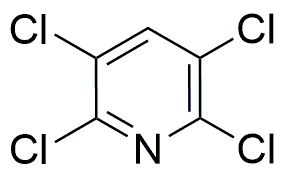2,3,5,6-Tetrachloropyridine is widely utilized in research focused on:
- Pesticide Development: This compound is often used as an intermediate in the synthesis of herbicides and insecticides, helping to create effective solutions for agricultural pest control.
- Pharmaceutical Research: It serves as a building block in the development of various pharmaceuticals, particularly in creating compounds with antimicrobial properties.
- Analytical Chemistry: The chemical is employed in analytical methods to detect and quantify environmental pollutants, aiding in regulatory compliance and environmental monitoring.
- Material Science: It is used in the formulation of specialty coatings and polymers, enhancing the performance and durability of materials in industrial applications.
- Research on Chlorinated Compounds: The compound is valuable in studies investigating the environmental impact and degradation pathways of chlorinated organic substances.
General Information
Properties
Safety and Regulations
Applications
2,3,5,6-Tetrachloropyridine is widely utilized in research focused on:
- Pesticide Development: This compound is often used as an intermediate in the synthesis of herbicides and insecticides, helping to create effective solutions for agricultural pest control.
- Pharmaceutical Research: It serves as a building block in the development of various pharmaceuticals, particularly in creating compounds with antimicrobial properties.
- Analytical Chemistry: The chemical is employed in analytical methods to detect and quantify environmental pollutants, aiding in regulatory compliance and environmental monitoring.
- Material Science: It is used in the formulation of specialty coatings and polymers, enhancing the performance and durability of materials in industrial applications.
- Research on Chlorinated Compounds: The compound is valuable in studies investigating the environmental impact and degradation pathways of chlorinated organic substances.
Documents
Safety Data Sheets (SDS)
The SDS provides comprehensive safety information on handling, storage, and disposal of the product.
Product Specification (PS)
The PS provides a comprehensive breakdown of the product’s properties, including chemical composition, physical state, purity, and storage requirements. It also details acceptable quality ranges and the product's intended applications.
Certificates of Analysis (COA)
Search for Certificates of Analysis (COA) by entering the products Lot Number. Lot and Batch Numbers can be found on a product’s label following the words ‘Lot’ or ‘Batch’.
*Catalog Number
*Lot Number
Certificates Of Origin (COO)
This COO confirms the country where the product was manufactured, and also details the materials and components used in it and whether it is derived from natural, synthetic, or other specific sources. This certificate may be required for customs, trade, and regulatory compliance.
*Catalog Number
*Lot Number
Safety Data Sheets (SDS)
The SDS provides comprehensive safety information on handling, storage, and disposal of the product.
DownloadProduct Specification (PS)
The PS provides a comprehensive breakdown of the product’s properties, including chemical composition, physical state, purity, and storage requirements. It also details acceptable quality ranges and the product's intended applications.
DownloadCertificates of Analysis (COA)
Search for Certificates of Analysis (COA) by entering the products Lot Number. Lot and Batch Numbers can be found on a product’s label following the words ‘Lot’ or ‘Batch’.
*Catalog Number
*Lot Number
Certificates Of Origin (COO)
This COO confirms the country where the product was manufactured, and also details the materials and components used in it and whether it is derived from natural, synthetic, or other specific sources. This certificate may be required for customs, trade, and regulatory compliance.


